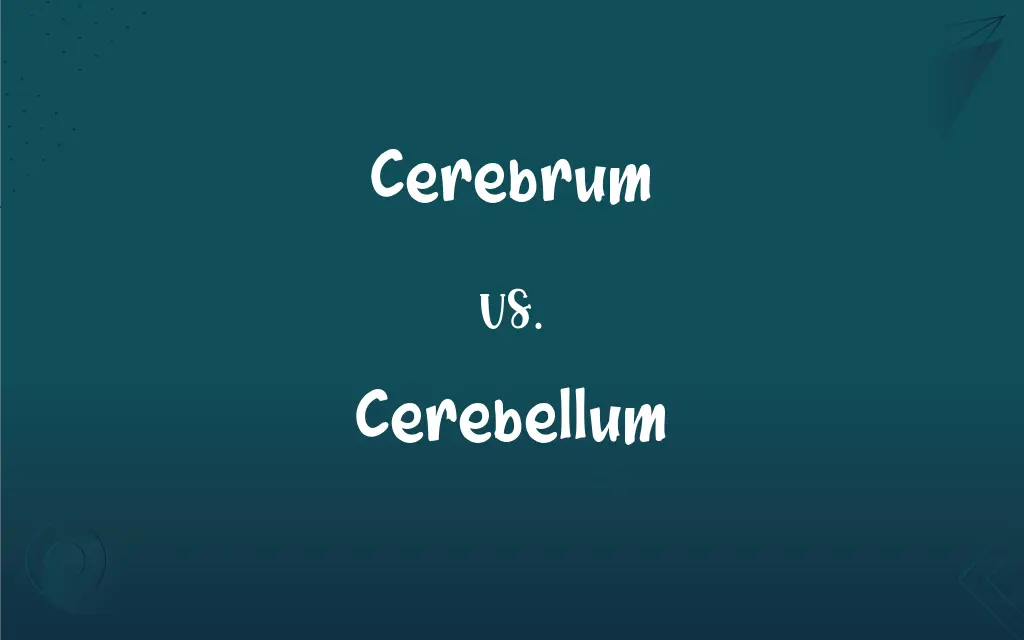Cerebrum vs. Cerebellum: What's the Difference?
Edited by Janet White || By Harlon Moss || Updated on June 30, 2024
The cerebrum is the brain's largest part responsible for thought, senses, and voluntary muscle activity; the cerebellum controls coordination and balance.

Key Differences
The human brain is a complex and intricate organ, with the cerebrum and cerebellum being two of its significant parts. The cerebrum, which is the largest part of the brain, encompasses the cerebral hemispheres and is involved in a variety of functions, including reasoning, learning, and memory. The cerebellum, smaller and located below the cerebrum, mainly deals with motor control, coordination, and balance.
While the cerebrum processes sensory information and directs voluntary muscular movements, the cerebellum ensures that these movements are smooth and coordinated. If you think of the cerebrum as the brain's command center for decision-making, you can view the cerebellum as the expert in precision, making sure each movement is carried out accurately.
Functionally, both the cerebrum and cerebellum have their specialties. The cerebrum, with its two hemispheres, handles tasks like problem-solving, emotions, and determining left from right. On the other hand, the cerebellum, which means "little brain" in Latin, refines the motor actions initiated by the cerebrum, ensuring stability and precision.
Anatomically, the cerebrum's surface is characterized by gyri (raised portions) and sulci (grooves), forming a wrinkled appearance. This structure increases the surface area, facilitating complex cognitive functions. The cerebellum also has a folded appearance, with folia (thin parallel folds) that allow it to process and integrate vast amounts of information regarding motor control.
Comparison Chart
Location
Upper part of the brain
Below the cerebrum, at the brain's back
ADVERTISEMENT
Function
Thought, senses, voluntary muscle activity
Coordination, balance, refining motor actions
Size
Largest part of the brain
Smaller than the cerebrum
Structure
Gyri and sulci; two hemispheres
Folia; appears like a separate mini-brain
Meaning
Derived from Latin for "brain"
Latin for "little brain"
Cerebrum and Cerebellum Definitions
Cerebrum
The seat of intelligence, consciousness, and emotion in the brain.
Emotional responses are generated in the cerebrum.
ADVERTISEMENT
Cerebellum
The brain structure responsible for balance and coordination.
Dancers often have a highly trained cerebellum to maintain their poise.
Cerebrum
The brain's primary region responsible for thought and action.
Her cerebrum was actively engaged in solving the puzzle.
Cerebellum
Key in learning motor behaviors and ensuring equilibrium.
Gymnasts rely on their cerebellum for their intricate routines.
Cerebrum
Responsible for voluntary muscular activities.
The athlete's cerebrum directed his muscles during the race.
Cerebellum
The "little brain" at the back of the brain.
The cerebellum plays a vital role in maintaining posture.
Cerebrum
The structure encompassing the brain's two hemispheres.
The cerebrum's right hemisphere is often linked with creativity.
Cerebellum
Processes motor information and integrates it for fine-tuning.
Her cerebellum corrected the imbalance as she stumbled.
Cerebrum
The area in the brain that processes sensory information.
When she touched the hot stove, her cerebrum reacted quickly.
Cerebellum
Ensures smooth, precise motor actions.
The cerebellum refines the movements initiated by the cerebrum.
Cerebrum
The large rounded structure of the brain occupying most of the cranial cavity, divided into two cerebral hemispheres that are joined at the bottom by the corpus callosum. It controls and integrates motor, sensory, and higher mental functions, such as thought, reason, emotion, and memory.
Cerebellum
The trilobed structure of the brain, lying posterior to the pons and medulla oblongata and inferior to the occipital lobes of the cerebral hemispheres, that is responsible for the regulation and coordination of complex voluntary muscular movement as well as the maintenance of posture and balance.
Cerebrum
(neuroanatomy) The principal and most anterior part of the brain in vertebrates, which is located in the front area of the skull and divided into two hemispheres, left and right, separated by a fissure. In humans it is the largest part of the brain and is responsible for the integration of complex sensory functions and the initiation and coordination of voluntary activity, and the higher mental functions such as consciousness, thought, reason, emotion, and memory.
Cerebellum
(neuroanatomy) Part of the hindbrain in vertebrates. In humans it lies between the brainstem and the back of the cerebrum and is formed of two lateral lobes and a median lobe. It plays an important role in sensory perception, motor output, balance and posture.
Cerebrum
The anterior, and in man the larger, division of the brain; the seat of the reasoning faculties and the will. See Brain.
Cerebellum
The large lobe of the hind brain in front of and above the medulla; the little brain. It controls combined muscular action. See Brain.
Cerebrum
Anterior portion of the brain consisting of two hemispheres; dominant part of the brain in humans
Cerebellum
A major division of the vertebrate brain; situated above the medulla oblongata and beneath the cerebrum in humans
FAQs
Are the cerebrum and cerebellum connected?
Yes, they are interconnected and communicate via neural pathways.
Are the functions of the cerebrum localized?
Yes, different regions of the cerebrum are responsible for different functions, like the frontal lobe for reasoning and the occipital lobe for vision.
Are cognitive functions processed in the cerebellum?
While the cerebellum primarily handles motor functions, it does play a role in some cognitive processes.
Is the cerebrum divided?
Yes, it's divided into two hemispheres: left and right.
What is the cerebrum's primary function?
The cerebrum handles thought, sensory processing, and voluntary muscle activity.
Where is the cerebrum located in relation to the cerebellum?
The cerebrum is above, and the cerebellum is below and toward the back.
Are the two cerebral hemispheres identical?
They're similar but have functional differences; for example, language typically resides in the left hemisphere.
Does injury to the cerebellum affect intellect?
While the cerebellum is not the primary center for intellect, injury can impact certain cognitive tasks.
Which part of the brain helps with learning a new sport or physical activity?
Both the cerebrum and cerebellum play roles, but the cerebellum refines the motor skills involved.
If I have trouble with balance, could my cerebellum be involved?
Yes, the cerebellum plays a key role in balance and coordination.
Does the cerebellum have any role in thought processes?
It's mainly involved in motor functions but does contribute to certain cognitive tasks.
How do the cerebrum and cerebellum communicate?
They're interconnected through neural pathways, allowing for communication.
Can someone live without a cerebellum?
It's crucial for many functions, but there are rare cases where individuals live without a fully developed cerebellum, albeit with challenges.
Which is larger, the cerebrum or the cerebellum?
The cerebrum is the larger of the two.
Which part of the brain handles emotions and reasoning?
The cerebrum is responsible for emotions and reasoning.
Why is the cerebrum's surface wrinkled?
The wrinkles, or gyri and sulci, increase the surface area for more neural connections.
What happens if the cerebrum is damaged?
Damage can affect various functions like movement, sensation, reasoning, and more, depending on the injury location.
Is the cerebellum involved in reflex actions?
Yes, it helps in refining and coordinating reflex movements.
What does the cerebellum primarily control?
The cerebellum controls balance, coordination, and refined motor actions.
What does the word "cerebellum" mean?
Cerebellum means "little brain" in Latin.
About Author
Written by
Harlon MossHarlon is a seasoned quality moderator and accomplished content writer for Difference Wiki. An alumnus of the prestigious University of California, he earned his degree in Computer Science. Leveraging his academic background, Harlon brings a meticulous and informed perspective to his work, ensuring content accuracy and excellence.
Edited by
Janet WhiteJanet White has been an esteemed writer and blogger for Difference Wiki. Holding a Master's degree in Science and Medical Journalism from the prestigious Boston University, she has consistently demonstrated her expertise and passion for her field. When she's not immersed in her work, Janet relishes her time exercising, delving into a good book, and cherishing moments with friends and family.































































